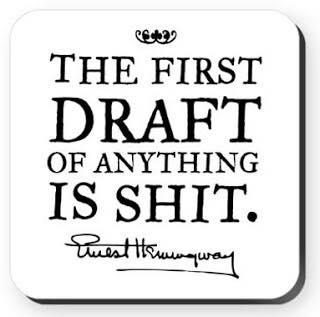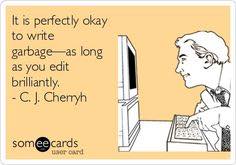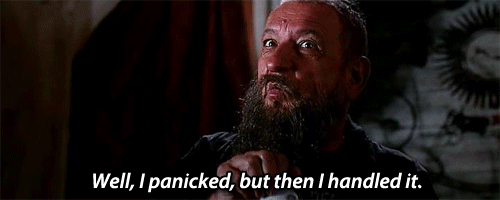Because I work better under it?
Or maybe it’s just that I’ve finally managed to locate the circle hole for the circle peg?
At least, I hope. Who knows, after I meet with Amanda again tomorrow she might tell me I’ve got an oval peg, not a circle and I’ll have to start it all over again.
I’ve described this to my dad as “getting all of my ducks in a row and then having someone come and scare them and leave”. And I have to start all over again.
But hopefully that duck-tape I’m using on those ducks actually works 🙂
Anyway, here’s some information I’m going to edit to put together a rough-draft for my proposal for Amanda for tomorrow.
I just have to remember that: And that
And that

And I’ll get through this thing.
So, without further ado, my notes:
Sami Weatherholt
Master’s Thesis
Proposal
2016
Fairies, Witches, and Spirits, Oh My!
Notes and the Like:
The three “magical creatures” that I have chosen to write about are:
- Fairies (All)
- Witches (All)
- Spirits (Specifically those linked with childhood, such as “the Boogeyman” and “The Sandman”)
Back-up creatures, just in case, include:
- Wendigo/Witico
- Dragons
- Big Foot/Sasquatch
Also, I have found that “convergence culture” is not what I’m looking at and instead have found that I’m leaning more towards transmedia/multimodal works.
Their definitions are as follows:
Transmedia: “Transmedia storytelling (also known as transmedia narrative or multiplatform storytelling, cross-media seriality) is the technique of telling a single story or story experience across multiple platforms and formats using current digital technologies; [it] involves creating content[3] that engages an audience using various techniques to permeate their daily lives”.
Multimodal: “Multimodality describes communication practices in terms of the textual, aural, linguistic, spatial, and visual resources – or modes – used to compose messages.[1] Where media are concerned, multimodality is the use of several modes (media) to create a single artifact. The collection of these modes, or elements, contributes to how multimodality affects different rhetorical situations, or opportunities for increasing an audience’s reception of an idea or concept. Everything from the placement of images to the organization of the content creates meaning”.
An example could be like the Scene It games J
So, yes. This helps by like 10,000% as now I can start to grasp the creation of my works and why I’m doing what I’m doing; how I’m creating my thesis.
The other thing I can work with as I learn more about transmedia and multimodal is how fairies, witches, and spirits have come in contact with them.
In other words, how all three of them have been placed in context to the definition?
I’m actually still a little fuzzy on how this works, but I have a feeling if I talk to Amanda she might be able to work it out a little better.
But, for my main three, I’ve got some examples I think will work:
- Fairies
- Fairly Oddparents
- Disney Fairies (Aka Tinkerbell)
- Strange Magic (movie)
- The Blue Fairy (Pinocchio)
- The Green Fairy (Absenthe)
- Fairy Godmother
- Rainbow Fairies (book series)
- Titiania (AM-SND; Queen) and Oberon (King)
- SPN “Fight those Fairies”
- Tooth Fairy
- Witches
- Wizard of Oz
- Dahl’s
- Harry Potter
- Hansel and Gretal
- Shakespeare
- Hocus Pocus
- W.I.T.C.H.
- Sabrina
- Bewitched
- Buffy
- Spirits
- Jack Frost
- 2 movie adaptations
- Rise of the Guardians
- Father Christmas
- Narnia
- Santa Claus(e)
- Rise of the Guardians
- Mr. Sandman
- Neil Gaiman
- Powerpuff Girls
- Rise of the Guardians
- The Boogeyman
- Don’t look under then bed
- Powerpuff Girls
- Rise of the Guardians
- Scary movie adaptation?
- Easter Bunny
- Peter Cottontail
- Hop
- Rise of the Guardians
- Easter Beagle
- Jack Frost
And those are just some of the things that have been used in reference to pop culture and trans/multi stuff.
Again, I’m not too sure how it’s all going to work out, but I’m going to talk it over with Amanda and see just exactly what she thinks about how it’s all going to work out.
I mean, from a trans/multi point of view.
I think, what I’m trying to imply, is how something like fairies, for example, have been updated and adapted into modern society and why. AKA Why have fairies been updated and adapted into modern society.
And actually, Zootopia kinda fits in with this ideology—the idea that animals are no longer “savage” or cute sidekicks and anthropomorphized them. I think that anthropomorphizing animals fits in perfectly as an example of what I’m going at.
Or, for Annette’s paper, why fairytales have been adapted and updated—like the case for Snow White.
And what I seek to do with this project is extend this ideology into hyper-realism. As a “pretend” educational tool. Of presenting “the other” as real and something that actually exists.
In other words, it’s Harry Potter-ing the world of magical creatures from fairytales, myths, and legends. But in the format of education presented towards everyone, not just a magical protagonist in a book.
I’m literally combining Harry Potter with the Ologies books. And making it interactive.
I’m commenting on how trans/multi can be used as an educational tool; to turn “instruction to delight”. To make education fun? A fake education that is.
Now I’m just confusing myself.
My purpose to writing this is to show-case the Jouissance and Plaisir of a trans/multi interactive text through the use of magical creatures.
I think.
I should probably throw in some fan-content related stuff too, just because I feel like it needs to be said, seeing as how that’s why I made up this thing in the first place.
How fans show-case their work through different mediums?
I’m so confused. I hope I don’t confuse Amanda with this. I feel like if I try to talk-explain it to her it’ll be more confusing, but if I write it down, it’ll come out clearer and she can physically see the confusion I’m running into.
Okay, time to move on and work on another part of my thesis that I’ve been doing research on!
That is, the exact definition of the Jouissance and Plaisir I want to use!
And that would be Roland Barthes’s Jouissance and Plaisir—which I’m pretty sure she skipped over in our last meeting for whatever reason.
So, in The Pleasures of Children’s Literature, Nodelman writes of Barthes’s Jouissance and Plaisir as “‘Texts of pleasure: the text that contents, fills, grants euphoria; the text that comes from culture and does not break with it, is linked to a comfortable practice of reading. Text of bliss: the text that imposes a state of loss, the text that discomforts (perhaps to the point of a certain boredom), unsettles the reader’s historical, cultural, psychological assumptions, the consistency of his tastes, values, memories, brings to a crisis his relation with language’ (14). The first of these offers the pleasures of the familiar. It gives readers what they expect and like. The second offers the pleasure of the strange. It upsets readers’ expectations in ways that free them from the familiar… ‘Texts of bliss’ tend to be noticeably anarchic, weird, innovative in structure and content” (23-24). In other words, Plaisir is one that the reader is used to. In my case, it is the sense of magical creatures they know from repertoire as well as this idea that they exist—thanks to the tales they come from. They’re also comfortable with the book format and to some extent, the idea of education. And, if we’re generating towards an audience with knowledge of something like Pottermore or Percy Jackson, they’ll be familiar with modern-day settings of magical creatures, etc. The Jouissance that I’m proposing is that of the format in which the book will rely upon—the pull-outs and extras and interactivity. It’s relatively new and slightly uncomfortable (which can lead to boredom; kind of like pulling the same prank to a bunch of people after they already know what’s coming. Think: Jack-in-the-Box). If they become accustom to “in order to view more, you have to pull this out/do this action”, the Jouissance will wear down (like writing a thesis and editing it. Over and over and over and over again). The ideology that magical creatures also have a home life; that they do ordinary things and keep ordinary, real-world workings is also a height of Jouissance that can result in boredom—because yeah, it’s cool to think that fairies walk among us, doing day-to-day things (or Lutins living in grocery stores), but to A) apply this notion to every creature and B) discover that their lives are no different than ours (with the exception of the fact that, hey, they’re mythical magical creatures) and it becomes boring. Which is why TV shows like Bewitched, The Fairly Oddparents, and even movies that feature the Santa Claus story lose their luster and become boring (this is also known as “beating a dead horse” in some cases). But when it first starts, it’s new, uncertain, and exciting! It brings bliss to those that read it! They’re not quite sure what it’s going to do, but they have a gut feeling that it’s going to be fun! It’s bodily pleasure they’re experiencing too—as it surges through them (think: Like a Virgin, Hey!)—just like when someone becomes a new fan of something. Or discovers Tumblr for the first time.
What I plan on doing is exploring this idea of Jouissance and Plaisir in my own writings to show-case…something. And here’s where I become foggy again. Like I’m missing the connectors. But at least I made sense of the Jouissance and Plaisir! Yay!
Now, for my last subject, “Book as Object”. I’ve narrowed that down to “Interactive text/narrative”—which I don’t know if that can be a thing; I’ll have to ask Amanda. Because that book she recommended has very little on what I want. Of course I haven’t read it all, but…it is what it is.
I did, however, find this really cool book on interactive narrative and how to write it (mental note, pack all these books), called Pause & Effect: The Art of Interactive Narrative by Mark Stephen Meadows. It talks a lot about the different kinds of interactive narratives (IN) and what one has to do to achieve the right balance in an IN. For example, a quote, “An author or designer has some control over the story. The story, however, because it’s interactive, needs to provide control to the reader as well. A heavily designed story, such as one of the 1980’s Choose Your Own Adventure books, conceived and invented by Ray Montgomery, is heavily impositional. It guides you with strict sets of individual rules that only allow the reader a narrow margin of decisions. Another example is Liquid Stage in which the viewer of the show has only particular moments of interaction available and the rest of the show is a dictated and sequential story. Expressive, in contrast to this, relies less on the series of events and behaves more like architecture: The visitor is allowed to roam freely, explore, investigate, and make changes in the environment. The specifics of a narrative plot are far less defined and, as a result, the breadth of interaction is much wider. Examples of this generally show up in 3-dimensional interfaces and narratives such as Ultima Online” (63). So, what he is saying is that there’s Impositional (the first) and Expressive (the second) and that one needs to find a balance between the two.
The book (particularly this point, not so much everything else) is really facisnating and I’m glad I serendipity’d my way to it!
Also, it reminds me of that game, “Gone Home”. So there’s that 🙂
So yes.
Now to turn this into a decent first draft.
Which on second thought I should change to “writing notes draft” instead. Because what I’ll be turning in on the 15th is essentially a first draft.
How lovely.
There’s no way I’m getting this proposal done by the end of the semester.
HAHAHAHAHAHAHAHAHAHAHA
In other news, I found the perfect reaction to how my writing process goes:

And I think I’ll end on that note.
Until Next Time,
Sami
